ENCORE - PRO MODIFIED: THE QUICK EIGHT ERA, PT. 2
Originally published 11-24-2009
The Movement Begins To Shape Into Something Special …
READ ALL FOUR PARTS OF THE SERIES …
PART ONE – THE FORMATIVE YEARS
PART TWO - THE MOVEMENT TURNS INTO SOMETHING SPECIAL
PART THREE - THE MOVEMENT IS CHRISTENED AS PRO MODIFIED
PART FOUR - AN ELIMINATOR IS BORN
In the previous installment, we touched on the misnomers of how Pro Modified began and how the pre-Pro Modified doorslammers became a favorable match race ticket in the Carolinas. There was also the groundswell of media attention this new style of heads-up, professional style drag racing generated.
In part two, CompetitionPlus.com delves into the world’s fastest group, an unofficial group that was spawned from these pre-Pro Modified drivers seeking out a niche, the milestone pursuits and the uncertainty of 1988.
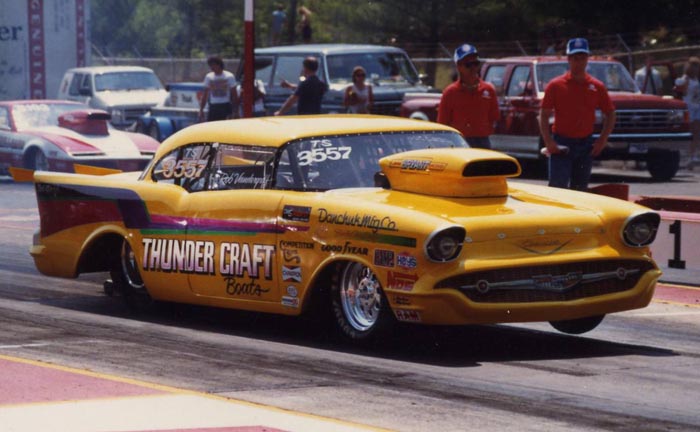
If you raced Top Sportsman during the years of 1986 through 1989, it was important that you brought a label to the race. Usually that label was the
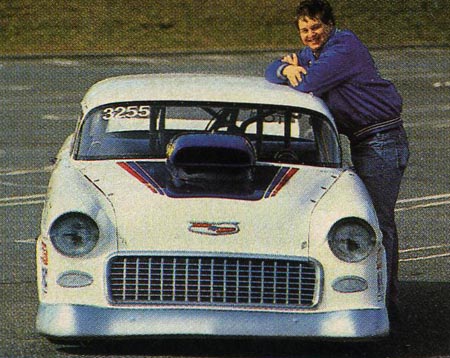
world’s fastest [insert car year and make here] and that was usually enough of a calling card to generate match races, t-shirt sales and magazine articles.
There was no official World’s Fastest Group per se, but the ability to claim a niche in the fast-growing class was enough for the multitude of teams in the fledgling movement to seek out a unique identity.
R.C. Sherman’s unheralded introduction didn’t inspire any real titles, but when Dave Bishop proclaimed Charles Carpenter’s 1955 Chevy as the “World’s Fastest ’55 Chevy” – those immortal words spoken by a part-time journalist was enough to inspire other racers.
Shortly after Bishop's proclamation, Robbie Vandergriff, a sportsman drag racer and cousin of Top Fuel racer Bob Vandergriff Jr., joined forces with businessman Jim Bryant to field a 1957 Chevy. As Carpenter and Vandergriff gained notoriety for their “World’s Fastest” shoeboxes, their exploits inspired two more doorslammers.
Former Comp eliminator racer Norm Wizner introduced a 1957 Ford, while Florida chassis builder Richard Earle unveiled a 1958 Plymouth Fury. Adding to the growing lure of the class, these cars represented the next generation in fast nostalgia racing with sleek fiberglass bodies mounted on Pro Stock style chasses. They had themes such as Wizner’s “Mega Ford”, a car designed to cater to the Ford fans starved for shoebox action.
Earle’s was probably the most unique of the shoebox quartet as it was based on the sinister vehicle from the Stephen King thriller Christine.
Except for the hood scoop and the potent B-1 wedge under the hood, the Mopar was a spitting image of the movie car.
Shortly after these cars hit the strip, others started to surface such as Gordy Foust’s 1966 Chevelle, Lamar Walden’s “World’s Fastest 409” 1962 Impala, Scotty Cannon’s Top Fuel-winged Willys Jeep, Tommy Mauney’s small-block Opel, Jim Honeycutt’s 1967 Camaro, Sonny Tindal driving the Gaffney Brothers’ 1968 Nova, Jim Wheatley’s 1966 Chevy II and Terry Leggett’s 1955 Thunderbird. There were others; the list seemingly a quarter-mile long.
And these were not your average drivers intent on selling a t-shirt with a greasy handprint on it. Many were methodical in their approach and promotion.
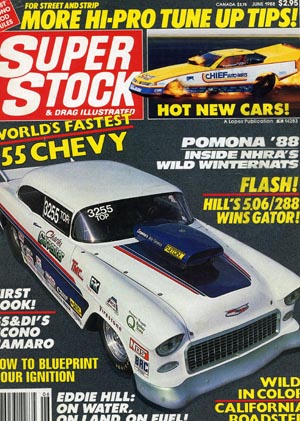
Back in those days, many of them had a magazine editor or their favorite photographer on speed dial. Those inserts into the major media outlet served as unpaid advertisements for match race bookings.
“I wouldn’t say that we had their number on speed dial, but they’d take our calls any time,” said Charles Carpenter.
“They were building the weird stuff for the same exact reason that the Funny Car and Dragster guys built the weird stuff – for bookings,” said Bret Kepner longtime drag racing journalist and former IHRA announcer. “When Christine was built, it was not to win IHRA national events. It was built to get a spot on the match race circuit. These cars were built to be noticed.”
Carpenter benefitted from the media exposure that being a member of the World’s Fastest Group produced.
“The media was the key to our survival and growth,” said Carpenter. “That media hype and exposure fueled the fire. There wasn’t an internet and those magazines were the only connection we had to the race fans and industry.”
During the peak period of his race team, in 1988, Carpenter ran 53 races and match races.
“At times we were racing as many as three different times a weekend at three different places,” said Carpenter. “We were zig-zagging the country as much as humanly possible. We’d have to turn down dates because I couldn’t do them all.
“It will never be like that again. Back in those days, there probably weren’t 20 Pro Mod type cars around in the United States. Now there are 20 in every neighborhood.
“I’ve said it before. I never set out to do what I did. I was just doing what I loved to do. I was just racing my 1955 Chevy and it all evolved into that. It just came naturally and that was the sweetest part of it all.”
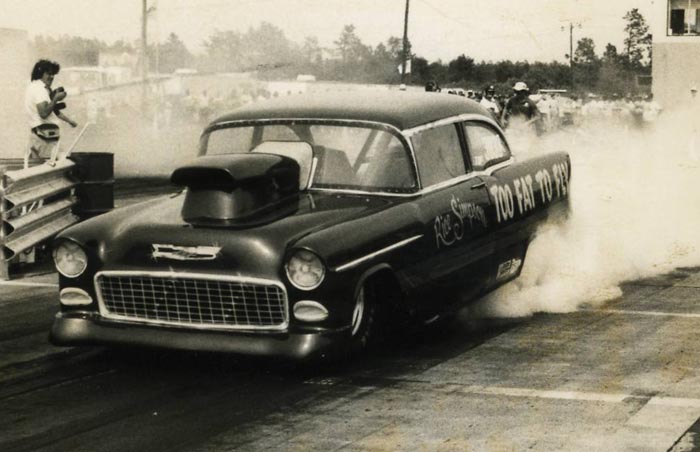 Some of the pre-Pro Mod Top Sportsman entries ranged from the odd mid-engine 1955 Chevy to the absurd with Ernie Wrenn's 1970 Chevy C-10 truck.
Some of the pre-Pro Mod Top Sportsman entries ranged from the odd mid-engine 1955 Chevy to the absurd with Ernie Wrenn's 1970 Chevy C-10 truck.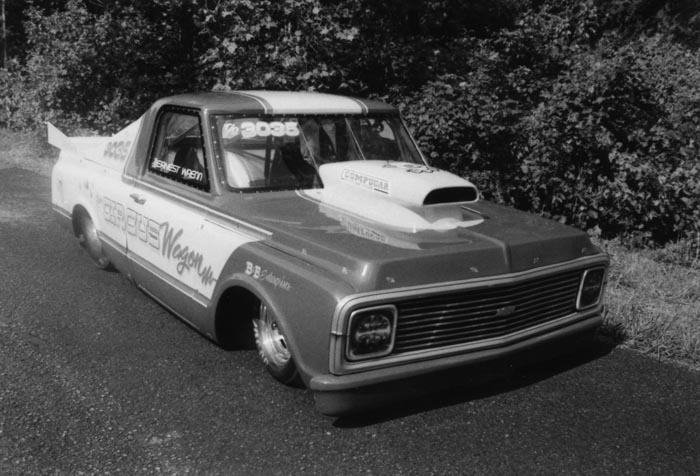
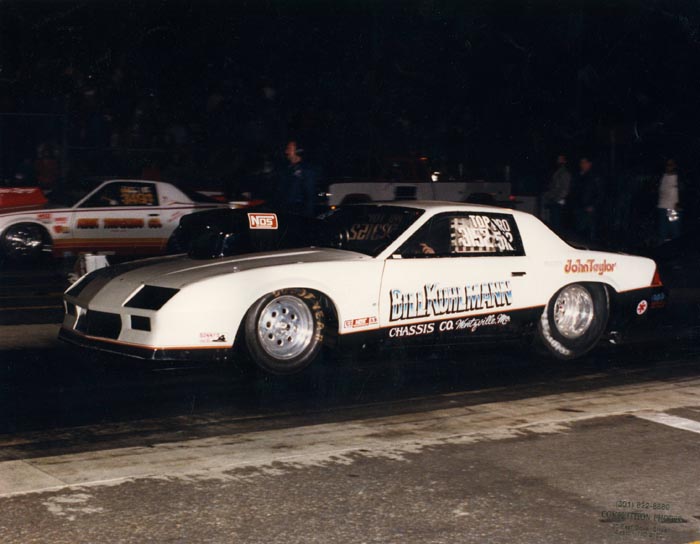
The media also played a significant role in hyping the performance milestones.
SS&DI tracked the players in the race to the first doorslammer six second run and first pass over 200 miles per hour.
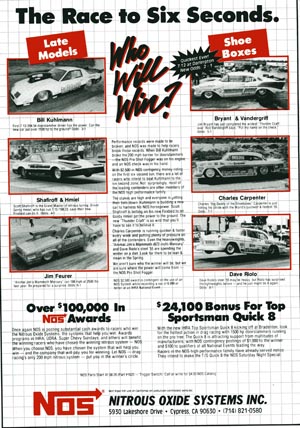
The magazine never published a race to the 200 mile per hour zone article, opting instead to focus on the key players capable of producing the first six second run first. That’s largely because SS&DI believed the six second zone would be broken first.
No one could have envisioned the 200 mile per hour speed barrier would fall first, nor could they have believed it would be an an obscure, low buck UDRA Pro Stock racer named Bill Kuhlmann that would pull off the feat.
Kepner’s list of likely suspects included Pro Stock legend (and oft mountain motor racer) Bob Glidden, Buddy Ingersoll, Robbie Vandergriff, Gordy Hmiel and Kuhlmann.
Kuhlmann was the long shot and was most likely to elicit the question,
“Who is that?”
After March 14, 1987, at 7:44 PM, Kuhlmann became a household name among gear-head drag racing fans.
“The only people who really knew of Bill Kuhlmann were those who went to UDRA races,” Kepner confirmed. “That wasn’t a helluva lot of people.”
Though Kuhlmann wasn’t considered a bona fide contender for the first 200, he believed he had as good of a chance as anyone.
“I thought I was in as good as shape as anyone else,” Kuhlmann said in an interview with SS&DI. “But even though my power/speed calculator told me I could do it, I didn’t know if it could be done.
“I know I had as good of a shot as the next guy.”
Kuhlmann built a drag racing career based off of that one memorable run. The next year he landed Summit Racing Equipment as a major sponsor and was immediately thrust into the forefront of the Top Sportsman division.
While Kuhlmann’s 202-mile blast became the kind of run legends were built on, Tommy “The Who” Howes’ six second pass had just the opposite effect.
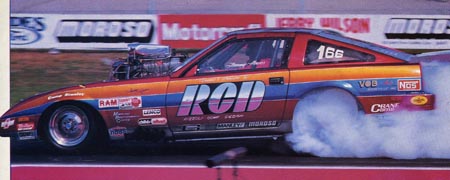 Tommy Howes recorded the first six second doorslammer run with his blown 300 ZX.
Tommy Howes recorded the first six second doorslammer run with his blown 300 ZX.
Almost 15 months later, Howes posted the first six-second doorslammer pass with a 6.993 at 201.77 miles per hour to become not only the first Top Sportsman driver to run a six-second pass but also a 200 mile per hour lap in a single run.
The media recognized the run [even National DRAGSTER] but his fellow Top Sportsman racers didn’t. His transgression was a supercharger protruding through the hood of his 300 ZX. There was that solid suspension too and the belief that Howes car was a Funny Car with doors.
“At the time Scott Shafiroff was working his butt off to have the first six-second doorslammer, and in fact, he was so sure that he was going to do it that he already had t-shirts printed up to commemorate the event,” said Howes, in a 2003 interview with CompetitionPlus.com. “It just so happens that his car was in the other lane when we lined up for the first round. I ran the Datsun through the traps at 6.996, 201.79, and the battle was on.
“Basically, it turned out that some of the nitrous cars, especially those sponsored by NOS and Mike Thermos, were really upset about an “illegal” car running the first six. Thermos was positive that his guy Shafiroff was going to run it, and when I went out and did it first it really took the wind out of his sails, and he got hot. NOS had put up $5,000 for the first car to run a six, but I never saw a dime of the money. They refused to pay me they were so bent out of shape. Mike and I had more than a few words over that in the months that followed, but to this day I haven’t seen his money. When all is said and done, though, we did it first, and we’re recognized as being the first, and that’s what really counts.”
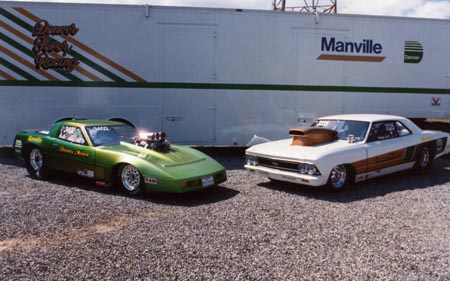 What the IHRA officials didn't realize is that the new movement of doorslammer racing was prepared to go to the next level with eighteen-wheelers and fast race cars such as the one fielded by the Denver Distribution team with Walter Henry's blown Corvette and Wally Bell's quick nitrous Chevelle.
What the IHRA officials didn't realize is that the new movement of doorslammer racing was prepared to go to the next level with eighteen-wheelers and fast race cars such as the one fielded by the Denver Distribution team with Walter Henry's blown Corvette and Wally Bell's quick nitrous Chevelle.
The sale of the IHRA by Larry Carrier to Billy Meyer could have been devastating to the progression of Pro Modified except for one thing. Top Sportsman was the one class that was never touched by the new owner.
Pro Stock, once the staple of IHRA’s doorslammer racing, was pulled from its mountain motor roots and forced to accept 500-inch entries, separated by weight breaks.
Sportsman racing was overhauled with the announcement that class racing had been discontinued and Rod classes lost their identities in favor of number index monikers.
Top Sportsman remained bracket racing at 200 miles per hour, except for one twist, a Quick Eight shootout for doorslammers on Saturday evening was added.
“When Billy Meyer took over the IHRA, his plan was to completely change the IHRA from a spectator perspective,” Kepner recalled. “Top Sportsman … he didn’t touch it.”
Top Sportsman was the only handicap eliminator spared from Meyer’s sweeping changes. Why? Kepner believes that four cars influenced Meyer’s decision to leave well enough alone.
Those cars in no certain order were Bill Kuhlmann’s Camaro, Robbie Vandergriff’s 1957 Chevy, Charles Carpenter’s 1955 Chevy and Richard Earle’s 1958 Plymouth Fury.
Meyer was reluctant to stage the Quick Eight events at first and his first question in response to Kuhlmann, one of the lobbyists pushing for the race within a race, became the foundation for the class’ mantra.
“How do you propose to race a class with no rules?” Meyer asked.
Kuhlmann responded, “You run whatcha brung and hope ya brung enough.”
Those Quick Eight events became as competitive on Saturday night as the professional racers were on Sunday. The IHRA selected the quickest eight doorslammer racers after Saturday afternoon’s final qualifying session.
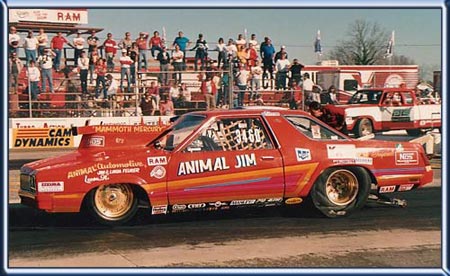 Animal Jim Feurer scored the first IHRA Top Sportsman Quick Eight victory.
Animal Jim Feurer scored the first IHRA Top Sportsman Quick Eight victory.
The eight racers kicked off the IHRA’s trademark Saturday Night of Fire with the first round, and have the subsequent elimination rounds sandwiched between the other professional qualifications.
“Animal” Jim Feurer, a former AHRA Pro Stock racer, competed in those early Quick Eight events and by virtue of his victory over Robbie Vandergriff at the 1988 IHRA Winternationals in Darlington, SC., gets credit for the first Quick Eight win. Feurer drove a Mercury Zephyr that he’d previously raced in AHRA Pro Stock.
“The IHRA didn’t put up any money,” confirmed Feurer. “It was basically money posted by Mike Thermos and contingency money that paid for it all. They just gave us the arena and the pit space. I think there was only about $1,500 in it.”
The crowd loved it and for Feurer, he needed no more proof than his wounded race car at the finish line to prove it.
“It was colder than hell and there was still a crowd there,” Feurer said. “We had some problems and couldn’t get the car started outside of a push start, so Robbie waited on us. I had Ron Colson, Mike Thermos, my crew and a race official who pitched in to help push start the car. It was awful dusty there and the car kept skidding in the dirt and dust. They were about to die back there pushing this car.
“It finally fired. We did our burnout and we left the line and it was a pedalfest. One time I got close to Vandergriff. I got the win light and I pulled off and here comes Vandergriff by, smiling, and he always smiled. He gave me a thumbs up and drove away, leaving me down there.
“I sat there and waited for a while until I realized no one was coming. I wondered where in the hell my guys were because they knew I couldn’t start the car up and drive away. Then I heard this cheer and wondered what the hell was going on.”
Shortly after that, a pair of jet cars ran down the track and then the fireworks went off, leaving Feurer wondering if his crew had truly forgotten their driver.
A crewman finally arrived and explained the situation to Feurer.
“I knew it was too cold for anyone to be exposing themselves,” Feurer said. “Come to find out, the officials were on the track and a whole crowd had followed them out, inspecting my tire tracks. They wanted to see if I had center-lined. When they pointed to my lane, the crowd cheered.”
That’s when Animal Jim and the IHRA both knew they were on to something big.
PART 3 – The IHRA Prepares for a Future Pro Class, How the Class Was Named, A Man with A Nitrous Company and Money to Spend, Blowers versus Nitrous - Coming







































